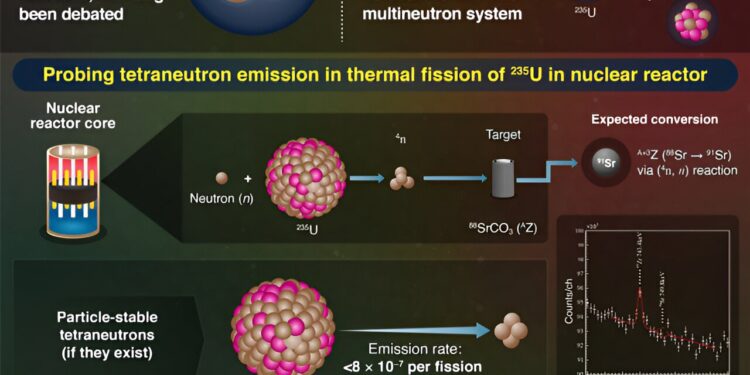Credit: Physical examination C (2023). DOI: 10.1103/PhysRevC.108.054004
The possible emission rate of the particle-stable tetraneutron, a four-neutron system whose existence has long been debated within the scientific community, has been studied by researchers at Tokyo Tech. They looked at the emission of tetraneutrons from the thermal fission of 235U by irradiating a sample of 88SrCO3 in a nuclear research reactor and analyze it by gamma ray spectroscopy.
The tetraneutron is an elusive atomic nucleus made up of four neutrons, the existence of which has been highly controversial among scientists. This mainly comes from our lack of knowledge about systems consisting only of neutrons, since most atomic nuclei are usually made of a combination of protons and neutrons. Scientists believe that experimental observation of a tetraneutron could be the key to exploring new properties of atomic nuclei and answering the age-old question: Can a neutrally charged multineutron system ever exist?
Two recent experimental studies reported the presence of tetraneutrons in the bound state and in the resonant state (a state that decays over time but lives long enough to be detected experimentally). However, theoretical studies indicate that tetraneutrons will not exist in a bound state if neutron interactions are governed by our common understanding of two- or three-body nuclear forces.
Intrigued, a team of researchers led by Associate Professor Hiroyuki Fujioka of the Tokyo Institute of Technology set out to study the feasibility of emitting bound tetraneutrons. In their recent study published in Physical examination Cthe team explored the possible rate of particle-stable tetraneutron emission via thermal neutron-induced fission of 235U (Uranium-235) in a nuclear reactor.
“We know from previous literature that the dominant thermal fission process for 235U is binary fission, which leads to the emission of two heavy nuclear fragments containing on average 2.4 neutrons. But there is a 0.2% probability of ternary fission, in which slight nuclear fragments are emitted. “We therefore chose this route for our experiment by assuming that the hypothetically bound tetraneutron could be a ternary particle in uranium fission,” explains Dr. Fujioka.
The team adopted the well-known method of instrumental neutron activation analysis, in which a trace element in a selected sample is irradiated and activated by the capture of thermal neutrons. For this study, 88SrCO3 was chosen as the target sample and was irradiated for two hours at a thermal power of 5 MW in a nuclear research reactor. The team also performed gamma ray spectroscopy on the irradiated sample in order to detect signals corresponding to possible tetraneutron emission.
THE 88The Sr nuclei had to convert into 91Sr with a Q value (mass change between the initial and final states of a reaction expressed in energy units) of 20 MeV minus the tetraneutron binding energy. From 91Sr is unstable, its radioactive decay followed by the release of γ rays would indicate the emission of stable tetraneutrons for particles.
Results of γ-ray spectroscopy for irradiated media 88The Sr sample, however, showed no photopeak corresponding to the formation of 91Sr. Based on this, the team estimated that if particle-stable tetranutrons existed, their emission rate could be lower than 8 × 10.-7 by fission at the 95% confidence level. They also suggested that improving sample purity and increasing the sensitivity of the experiment could help detect subtle signals from tetranutrons.
Dr. Fujioka said: “Our study showed that the instrumental neutron activation method in radiochemistry can be applied to answer the open question in nuclear physics. We will further improve the sensitivity to search for the elusive, neutrally charged system.
Although the team was unable to detect bound tetraneutrons, their work established a solid framework for future studies of elusive tetraneutrons and other similar systems.
More information:
Hiroyuki Fujioka et al, Search for particle-stable tetraneutrons in thermal fission of U235, Physical examination C (2023). DOI: 10.1103/PhysRevC.108.054004
Provided by Tokyo Institute of Technology
Quote: Hunting elusive tetraneutrons with thermal fission (January 4, 2024) retrieved January 5, 2024 from
This document is subject to copyright. Apart from fair use for private study or research purposes, no part may be reproduced without written permission. The content is provided for information only.



